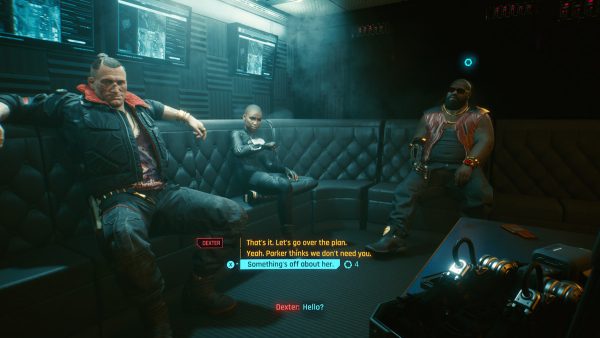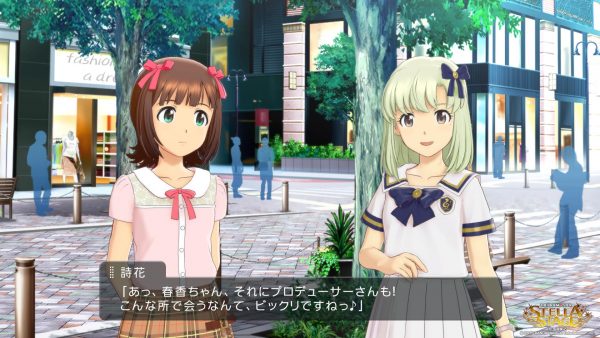
The World’s a Stage: Why Artifice Is Better Than Realism
Breton Campbell brings an unlikely comparison.
I stopped playing Cyberpunk 2077 near the beginning of Act 3, just as my avatar was preparing to mount a counterattack on the Big Baddies (I think). At this point, I was just eager to finish the game, but also dreaded the thought of jumping through a bunch of invisible hoops—specifically, talking to a bunch of characters I didn’t like—in order to satisfy the game’s demands and get a good ending.
A fairly minor setback, sure (and not something I would usually complain about), but this moment seemed to serve as the culmination of a problem I had been having with the game for a long time. Whereas initially I had felt that the game was encouraging me to immerse myself in the world and think like my avatar (e.g., befriend or reject any character I felt like), the dissonance between this supposed immersive texture and the gameplay goals that the game was encouraging me to achieve eventually became impossible to ignore. I refused to play along, so I dropped the blockbuster extravaganza for a different game, one which clarified my feelings on Cyberpunk’s missteps: a Japanese-language mid-budget game about hanging out with cartoon girls, The Idolmaster: Stella Stage.
“Why would I do this?” You might be asking. But just hang on for just a second! While these two games couldn’t be more different when it comes to genre, tone, etc., their core gameplay loops share some important similarities. Both feature roleplaying dialogue systems built around navigating social situations to gain future rewards. Both center interactions with a few key characters, prompting the player to become emotionally attached. The games choose different paths when it comes to tone, though, and this difference reveals a lot about what the games are really about. Cyberpunk hones in on a dialogue system that drives a sense of realism, while Stella Stage readily admits to being artificial: a videogame first and foremost. I found one of these approaches a tiny bit more effective than the other.

In Cyberpunk, the player is confined to a first-person perspective, and is often told to hurry up by their conversational partner(s) if they take too long to come up with a response. Time-limited dialogue options appear quite frequently, often used simply to keep the player an active participant in the scene. In these moments, time seems to flow in a realistic manner, despite the fact that the player is not usually rewarded or punished for failing to respond within a ‘realistic’ timeframe (though quick responses can at times resolve or prevent combat, combat is never enough of a threat to become a punishment). Instead, the player is motivated to respond quickly in order to preserve the flow of the scene, working alongside the game to produce a passably realistic social interaction. I often found this approach to be quite effective, the music and time-limited dialogue making me feel the same urgency my avatar felt in these tense moments.
But most of the time, I found the cinematic elements distracting rather than engaging. That’s because the game doesn’t commit to the realistic texture it tries to establish; it just can’t do that, because it’s a triple-A open world videogame, so it wants you to complete objectives, increase your numbers, trip over some romance flags, etc. This forces the player to care about both the organic, social aspects of the game’s surface reality (thinking how to best embody their character in each scene) as well as the linear goals that the game plops in front of them. Instead of letting me take my journey, it felt like the game was repeatedly intruding upon my experience.
Stella Stage, meanwhile, uses its borrowed dating sim elements to present conversational challenges and rewards that are immediately tangible. In the game’s main visual novel sections, the player must pick from a set of four responses at a specific point in the conversation. Like many of Cyberpunk’s conversation options, the player will only be given limited time to pick a response. Critically, though, this is not meant to feed into a sense of realism. The amount of time the player is given to respond doesn’t resemble the flow of a real conversation in the slightest. While Cyberpunk maintains the complete illusion of time marching forward when a player is asked to make a quick decision (with characters gesturing and talking at you to simulate a real interaction), in Stella Stage the world pauses when you’re asked to make a decision, with the game giving you a fixed amount of time to make a choice before the action resumes. The countdown and the tense music is more Pac-Man than Cyberpunk, simply by removing the illusion of a world existing outside of the player’s point of view. Due to a slight difference in presentation, the player feels compelled to prioritize advancing in the game over performing well as an avatar within a fictional world.

If the player successfully navigates a conversation with their chosen idol, the benefits are immediately tangible. These conversations (along with every other non-performance activity) provide a passive buff to the player (e.g. more money or fans earned during performances), which will last a certain number of in-game weeks depending on the specific activity.
Speaking of in-game weeks, I should mention that Stella Stage is an infinite game. The game is divided into weeks, during which the player can only select one action, but they are given an endless amount of weeks to train their idols and reach the top of the charts. This training is mainly conducted through a series of disembodied menus and minigames—clothing stores are digital catalogues, the upgrade point system is a board game, etc. Apart from the visual novel sections, the player is rarely expected to actually think of themselves as the producer, responding to the idols in a way that reflects any sort of real life interaction. They are asked to be observers of a static, infinite world, making choices that benefit them purely mechanically.
In a strange way, Cyberpunk’s open world is no different from Stella Stage’s menus; in fact, I found it revealing to think of Night City as just another set of static menus, waiting for the player to interact with it and reap the benefits. The game often has time-gated missions that unlock after an unclear amount of time has passed, but once these missions have been unlocked they’re available forever. The player can survey the environment and pick any activity they choose, while the rest of the city remains frozen in amber. The only difference is the pretense of an organic world.
I found myself far less bothered by the artifice of Stella Stage because I could quickly accept it as artifice and move on. The game never hid its inner designs with cheap diversions, the promise of a ‘realism’ that it could never offer. It never pretended to be anything more than a videogame. It told me to treat it as a puzzle and a challenge first and foremost, letting me fill in the gaps of the gamified conversations with a more complete mental narrative, incorporating my own progress through the game.

The conversations in Stella Stage are symbolized, not emulated. By extension, characters are meant to represent the idea of themselves, a sketched-out set of archetypes that is meant to take on even richer characteristics as the player continues to interact with them. And once they are hooked on Stella Stage, through its characters and its unashamedly videogame-y systems, the decisions they make will accrue and begin to alter those mental conversations.
For instance, I made my first idol, Takane, specialize in Solo concerts. Though I initially had difficulty with the rhythm gameplay, once I realized that playing solo concerts was far easier than group concerts, I found myself blazing through the content, only requiring stat buffs at one or two points. This gameplay ‘arc’ transformed my impression of Takane’s character to accommodate my gameplay decisions—In my mind, she is now a fiercely skilled and independently-minded soloist, who overcame her early struggles in group performances to stand tall on her own. The game never explicitly lays out this arc, of course, but the vague conversations leave plenty of room for it. Her excitement at overcoming the latest Rank Up Challenge mirrors my own excitement at reaching a new skill threshold, with my imagination allowing these parallel arcs to exist in perfect unison.
I could see a hundred different players identifying with these characters in a hundred different ways, depending on their past experiences and minute differences in their gameplay styles. Even when the game literally reuses cutscenes — sometimes different sets of girls will do the exact same thing in two different randomly occurring cutscenes, such as watching a scary movie at the end of the day — their effect on the player will be radically different depending on how they perceive these idols throughout the course of their playthrough. Cyberpunk, by contrast, was fixated on presenting its characters as human beings with their own, fully-formed, independent spirits, a hasty lie that fell apart instantly.
The best example I can think of when it comes to this specific brand of Cyberpunk clumsiness is the date with Judy, which occurs at the end of her questline. During this quest, you’re forced to explore the submerged remains of Judy’s hometown, scuba diving through the wreckage while hooked up to a VR device in order to simulate Judy’s auditory memories. I suppose that Cyberpunk is going for a sort of indie game hangout vibe here, stripping away the combat and the decision making in order to give you a setpiece that highlights the characters above all else. But Cyberpunk The Videogame doesn’t stop running when Cyberpunk: The Personal Narrative takes over. The game still provides you with repetitive meaningless tasks, tiny Triple-A micro-objectives that do nothing but hinder this illusion.

In the second half of the mission, you’re asked to interact with a bunch of random objects videogame-ingly placed in a series of clusters on the ocean floor. If you swim up to them and press a button, the game will dispense some Character Moments for you. There’s no reason that this sub-goal needs to exist—at the very least, these small character interactions shouldn’t be presented as optional, repetitive tasks. It’s pointless busywork for the sake of it. The entire level is like a puzzle room without a puzzle, or a dungeon without a dungeon. Compared to an actual videogame dungeon, the player is not given the freedom or solitude to construct their own internal narratives. The conversations themselves are janky and awkward, with dialogue being abruptly cut off as the player proceeds to a different area, or recycled in an unnatural way. At the end of the mission, when V collapses, it almost seemed as if Judy’s programmed monologue was improperly synced with V’s biochip malfunction — she was still prattling on about her childhood in a neutral tone as I collapsed onto the ocean floor, only becoming concerned right as I blacked out!
After that, I was given the choice to romance Judy or reject her (with a big ol’ lip icon beside the romance option, just in case I couldn’t figure it out myself). And shortly after that, I turned the game off and never played it again.
Well, maybe that’s not true. Maybe I’ll pick up Cyberpunk again someday, when I’m itching to run around in a neon sandbox, to kill some time for a few hours by stealing gear and shooting bad guys. But for the time being, I’d rather throw on something like Stella Stage. In the end, I just feel better about spending time with a game that’s up front about its escapist intentions, no matter the silly premise.
We need to cherish honesty in videogames, I think. We need to reward videogames that wear their limitations proudly, and invite you to look beyond those limitations to see something unique and wonderful laying beyond the horizon. Players don’t need to be guided by hand through their own journeys, after all. Who knows where their journeys would lead if we stopped trying to guide them down such narrow pathways. How valuable might these new, weirder experiences be?
Breton Campbell is a recent English graduate from Carleton University, interested in the harmonies and dissonances between games and stories. He’s currently the co-host of Phone Calls From Dad, a podcast about the Mother series of videogames. When he’s not rambling about Earthbound or getting beaten up in Street Fighter, you can (occasionally) find him on Twitter.